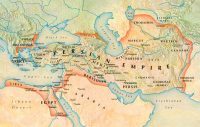Iran has a hot, dry climate characterized by long, hot, dry summers and short, cool winters. The climate is influenced by Iran’s location between the subtropical aridity of the Arabian desert areas and the subtropical humidity of the eastern Mediterranean area. January is the coldest month, with temperatures from 5°C to 10°C, and August is the hottest month at 20°C to 30°C or more.
In most of the areas, summers are warm to hot with virtually continuous sunshine, but high humidity on the southern coastal areas of the Persian Gulf. Daily Temperatures can be very hot; on some days temperatures can reach easily 40°C or more, especially along the Persian Gulf and Oman Sea which causes a danger of heat exhaustion.
About 70 percent of the average rainfall in the country falls between November and March; June through August are often rainless. Rainfall varies from season to season and from year to year. Precipitation is sometimes concentrated in local, but violent storms, causing erosion and local flooding, especially in the winter months. A small area along the Caspian coast has a very different climate, here rainfall is heaviest from late summer to mid winter but falls in general throughout the year.
Iran is one of the only countries in the world which has the complete four seasons .The land whose every inch needs deep evaluation. Its north is covered with evergreen forests and a beautiful lake with moderate climate, its south is led to the Persian Gulf, with hot and humid climate, beautiful and attractive palm trees, its east with a hot desert and running sand, with its nights full of stars and the west of this vast land with mountains high in the sky, attracts the attention of every visitor.
In other words, Iran possesses characteristics of all four regions, given its position at the crossroads of these four geo-climatic zones. It is a land of wonder, paradox and diversity, hence the appropriate title “Iran: a world inside a country”.In fact, Due to the large size of Iran, there can be great variation in weather conditions across the country. e.g. winter weather in the northwest of Iran is typically cold with heavy snowfall and subfreezing temperatures, whilst in the southern regions of Iran; the weather during this period is often fairly mild. However, cold air blowing from Siberia can produce some very cold weather during this period. Weather during the spring period in Iran is typically fairly mild and most of the rainfall seen in Iran occurs during the spring and winter periods.
However the weather within the Caspian coastal area of Iran (which is a high mountainous region) is very different to the rest of Iran and this area usually experiences rain fall throughout the whole year. Due to the different weather conditions in this country, the region is far more fertile to the rest of Iran which is typically fairly arid. Summer weather in Iran is typically very hot and dry. It is not uncommon for the temperature in the south of Iran to exceed 37 degrees centigrade during this period. The sun shines almost continuously during this season. Like the spring, autumn is a fairly short season in Iran and it’s advisable to visit at this time.
We, at Iran Traditional Hotels, are more than happy to give you more information and help you arrange your visit from Iran.
To organize your tailored-made trip to Iran, please click here.





